标签:ref 实现 color 节点 config 标签 table path ping
struts是流行和成熟的基于MVC设计模式的web应用程序框架,使用struts可以帮助我们减少运用MVC设计模型来开发web应用的时间。
目录:
一、struts2的工作原理及文件结构
二、三种访问Servlet API的方式
三、struts接收参数的三种方式
四、自定义拦截器
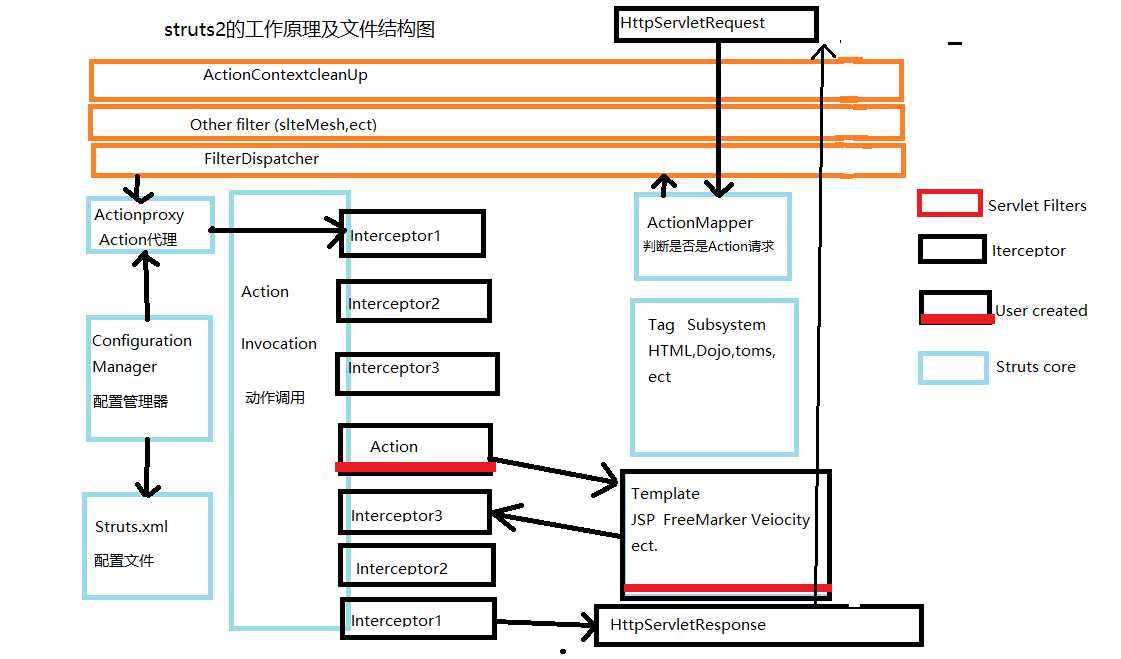
注:FilterDispatcher被替成StrutsPrepareAndExecuteFilter(如果使用FilterDispatcher过滤器时,程序员自己写的Filter过滤器必须放在所有过滤器的前面。而StrutsPrepareAndExecuteFilter过滤器可以让程序员在执行action之前写自己的Filter)
描述Struts流程:
网页产生HttpServletRequest请求->经过多个过滤器->到达ActionMaaper,判断是否是action请求(如果是)->通过StrutsPrepareAndExecuteFilter过滤器到达Actionproxy,一方面通过configuration Manager(配置管理器)读取struts.xml文档,另一方面创建一个实例,经过一系列的拦截器->执行到Action->返回result(对应了视图)->经过一系列的拦截器(逆序)->通过HttpServletResponse返回到用户实例。
struts2中没有提供任何一个servlet对象,不存在HttpServletRequest,HttpServletResponse对象。但是Struts2提供了三种方式间接的去访问Servlet API
通过ActionContext的getContext()静态方法获取ActionContext对象,通过ActionContext对象的一些getSession(),getApplication(),put()等方法,但是千万要注意的是,get获取到的对象都为Map键值对类型。com.opensymphony.xwork2.ActionContext
1 public String execute() { 2 if ("ping".equals(username)) { 3 /* 4 * ActionContext可以获得Servlet对象 但是无法获得response响应对象获得 5 * 获得的request、session、Application 都是Map类型 6 */ 7 8 ActionContext.getContext().put("用户名", username); 9 Map session=ActionContext.getContext().getSession(); 10 Map application=ActionContext.getContext().getApplication(); 11 Map request=(Map)ActionContext.getContext().get(StrutsStatics.HTTP_REQUEST); 12 } else { 13 ActionContext.getContext().put("info", "信息"); 14 } 15 return SUCCESS; 16 }
通过调用ServletActionContext类的一些包括getResponse(),getRequest(),getServletContext()等在内的静态方法,这些静态方法的返回类型是和Servlet中的对象类型是一一对应的。其中getResponse()返回类型为HttpServletResponse,getRequest()返回类型为HttpServletRequest().
1 public String execute2() throws IOException { 2 if ("ping".equals(username)) { 3 HttpServletResponse response=ServletActionContext.getResponse(); 4 HttpServletRequest request=ServletActionContext.getRequest(); 5 HttpSession session=ServletActionContext.getRequest().getSession(); 6 ServletContext application=ServletActionContext.getServletContext(); 7 } else { 8 9 } 10 System.out.println(username); 11 return SUCCESS; 12 }
(1)实现ServletRequestAware,ServletResponseAware,ServletSessionAware
1 public class LoginAction extends ActionSupport implements ServletRequestAware 2 3 4 private HttpServletRequest request; 5 //需实现方法 public void setServletRequest(HttpServletRequest request) { this.request=request; } //response示例 6 public String execute1() throws IOException { 7 if ("ping".equals(username)) { 8 response.setContentType("text/html;charset=utf-8"); 9 PrintWriter out = response.getWriter(); 10 out.print("<script type=‘text/javascript‘>alert(‘验证码输入错误!‘)</script>"); 11 out.print("<script type=‘text/javascript‘>location.href=‘/index.jsp‘</script>"); 12 out.flush(); 13 out.close(); 14 } else { 15 response.setContentType("text/html;charset=utf-8"); 16 PrintWriter out = response.getWriter(); 17 out.print("<script type=‘text/javascript‘>alert(‘验证码输入错误!‘)</script>"); 18 out.flush(); 19 out.close(); 20 } 21 System.out.println(username); 22 return SUCCESS; 23 }
(2)实现RequestWare、SessionWare、ApplicationWare等接口
public class LoginAction2 extends ActionSupport implements RequestAware,SessionAware, ApplicationAware { private Map<String, Object> request; private Map<String, Object> session; private Map<String, Object> application; //DI dependency injection //IoC inverse of control public String execute() { request.put("r1", "r1"); session.put("s1", "s1"); application.put("a1", "a1"); return SUCCESS; } @Override public void setRequest(Map<String, Object> request) { this.request = request; } @Override public void setSession(Map<String, Object> session) { this.session = session; } @Override public void setApplication(Map<String, Object> application) { this.application = application; } }
Struts有三种方式接收参数,且这三种方式都是自动完成赋值的setter方法。
代码:
struts.xml
<?xml version="1.0" encoding="UTF-8"?> <!DOCTYPE struts PUBLIC "-//Apache Software Foundation//DTD Struts Configuration 2.3//EN" "http://struts.apache.org/dtds/struts-2.3.dtd"> <struts> <package name="default" namespace="/" extends="struts-default"> <action name="LoginAction" method="login" class="com.third.LoginAction1"> <result>/loginSuccess.jsp</result> </action> </package> </struts>
login.jsp(登陆提示页面)
<%@ page language="java" contentType="text/html; charset=UTF-8" pageEncoding="UTF-8"%> <!DOCTYPE html PUBLIC "-//W3C//DTD HTML 4.01 Transitional//EN" "http://www.w3.org/TR/html4/loose.dtd"> <html> <head> <meta http-equiv="Content-Type" content="text/html; charset=UTF-8"> <title>Insert title here</title> </head> <body> <h1>login page</h1> <form action="LoginAction.action" method="post"> <table> <tr> <td>username:</td> <td><input type="text" name="username"/></td> </tr> <tr> <td>password:</td> <td><input type="password" name="password"/></td> </tr> <tr> <td><input type="submit" value="submit"></td> <td><input type="reset" value="reset"></td> </tr> </table> </form> </body> </html>
loginSuccess.jsp(登陆成功提示界面)
<%@ page language="java" contentType="text/html; charset=UTF-8" pageEncoding="UTF-8"%> <!DOCTYPE html PUBLIC "-//W3C//DTD HTML 4.01 Transitional//EN" "http://www.w3.org/TR/html4/loose.dtd"> <html> <head> <meta http-equiv="Content-Type" content="text/html; charset=UTF-8"> <title>login success!</title> </head> <body> <h1>login success!</h1> </body> </html>
LoginAction.java
1 package com.third; 2 3 import com.opensymphony.xwork2.ActionSupport; 4 5 public class LoginAction1 extends ActionSupport { 6 7 private String username; 8 private String password; 9 10 public String login(){
//这里能够打印出来传入的值,则说明能够自动调用setter方法完成赋值 11 System.out.println("username:"+username+" password:"+password); 12 return SUCCESS; 13 } 14 15 public String getUsername() { 16 return username; 17 } 18 19 public void setUsername(String username) { 20 this.username = username; 21 } 22 23 public String getPassword() { 24 return password; 25 } 26 27 public void setPassword(String password) { 28 this.password = password; 29 } 30 31 }
运行结果截图:
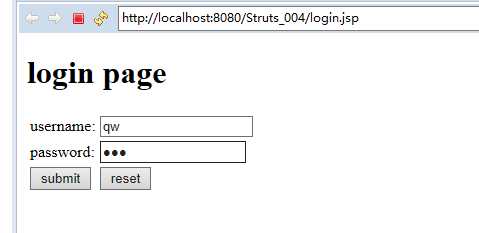
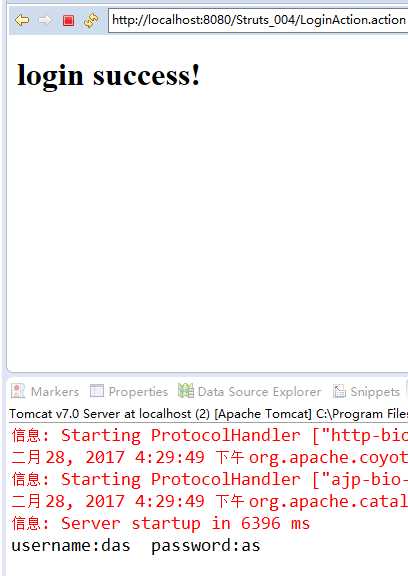
注:这里在表单传值是,必须指明这个属性值,到底穿个action中的那个引用,例如user.username.
代码:
struts.xml
<?xml version="1.0" encoding="UTF-8" ?> <!DOCTYPE struts PUBLIC "-//Apache Software Foundation//DTD Struts Configuration 2.1//EN" "http://struts.apache.org/dtds/struts-2.1.dtd"> <struts> <package name="default" namespace="/" extends="struts-default"> <action name="LoginAction" method="login" class="com.third.LoginAction"> <result>/loginSuccess.jsp</result> </action> </package> </struts>
login.jsp
<%@ page language="java" import="java.util.*" pageEncoding="UTF-8"%> <% String path = request.getContextPath(); String basePath = request.getScheme()+"://"+request.getServerName()+":"+request.getServerPort()+path+"/"; %> <!DOCTYPE HTML PUBLIC "-//W3C//DTD HTML 4.01 Transitional//EN"> <html> <head> <base href="<%=basePath%>"> <title>My JSP ‘login.jsp‘ starting page</title> <meta http-equiv="pragma" content="no-cache"> <meta http-equiv="cache-control" content="no-cache"> <meta http-equiv="expires" content="0"> <meta http-equiv="keywords" content="keyword1,keyword2,keyword3"> <meta http-equiv="description" content="This is my page"> <!-- <link rel="stylesheet" type="text/css" href="styles.css"> --> </head> <body> <h1>login page!</h1> <form action="LoginAction.action" method="post"> <table> <tr> <td>username:</td> <td><input type="text" name="user.username"/></td> </tr> <tr> <td>password:</td> <td><input type="password" name="user.password"/></td> </tr> <tr> <td><input type="submit" value="submit"></td> <td><input type="reset" value="reset"></td> </tr> </table> </form> </body> </html>
loginSuccess.jsp
<%@ page language="java" import="java.util.*" pageEncoding="UTF-8"%> <% String path = request.getContextPath(); String basePath = request.getScheme()+"://"+request.getServerName()+":"+request.getServerPort()+path+"/"; %> <!DOCTYPE HTML PUBLIC "-//W3C//DTD HTML 4.01 Transitional//EN"> <html> <head> <base href="<%=basePath%>"> <title>My JSP ‘loginSuccess.jsp‘ starting page</title> <meta http-equiv="pragma" content="no-cache"> <meta http-equiv="cache-control" content="no-cache"> <meta http-equiv="expires" content="0"> <meta http-equiv="keywords" content="keyword1,keyword2,keyword3"> <meta http-equiv="description" content="This is my page"> <!-- <link rel="stylesheet" type="text/css" href="styles.css"> --> </head> <body> <h1>login success!</h1> </body> </html>
User.java
package com.third; public class User { private String username; private String password; public String getUsername() { return username; } public void setUsername(String username) { this.username = username; } public String getPassword() { return password; } public void setPassword(String password) { this.password = password; } }
LoginAction.java
1 package com.third; 2 3 import org.apache.struts2.ServletActionContext; 4 5 import com.opensymphony.xwork2.ActionContext; 6 import com.opensymphony.xwork2.ActionSupport; 7 import com.opensymphony.xwork2.inject.Context; 8 9 public class LoginAction extends ActionSupport { 10 11 private User user; 12 public User getUser() { 13 return user; 14 } 15 16 public void setUser(User user) { 17 this.user = user; 18 } 19 public String login(){
//这里可以打印出传入的值的话,Action完成了自动调用setter方法赋值 20 System.out.println("username:"+user.getUsername()+" password:"+this.getUser().getPassword()); 21 return SUCCESS; 22 } 23 24 }
运行结果截图:
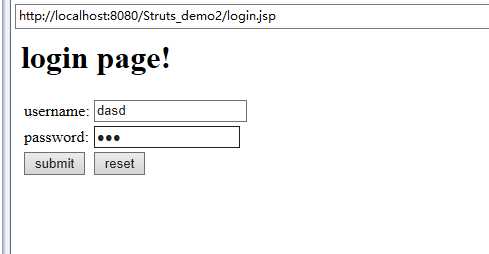
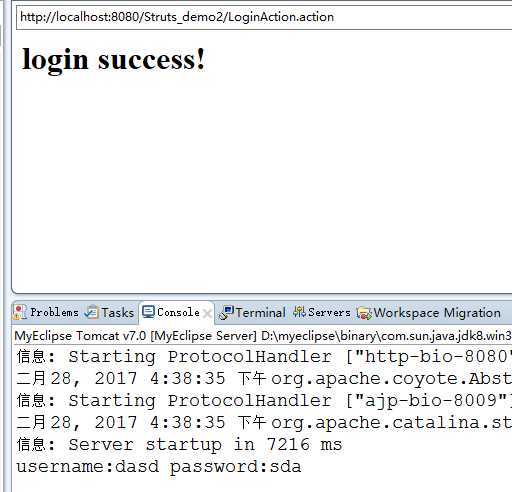
struts.xml
<?xml version="1.0" encoding="UTF-8" ?> <!DOCTYPE struts PUBLIC "-//Apache Software Foundation//DTD Struts Configuration 2.1//EN" "http://struts.apache.org/dtds/struts-2.1.dtd"> <struts> <package name="default" namespace="/" extends="struts-default"> <action name="LoginAction" method="login" class="com.third.LoginAction"> <result>/loginSuccess.jsp</result> </action> </package> </struts>
login.jsp
<%@ page language="java" import="java.util.*" pageEncoding="UTF-8"%> <% String path = request.getContextPath(); String basePath = request.getScheme()+"://"+request.getServerName()+":"+request.getServerPort()+path+"/"; %> <!DOCTYPE HTML PUBLIC "-//W3C//DTD HTML 4.01 Transitional//EN"> <html> <head> <base href="<%=basePath%>"> <title>My JSP ‘login.jsp‘ starting page</title> <meta http-equiv="pragma" content="no-cache"> <meta http-equiv="cache-control" content="no-cache"> <meta http-equiv="expires" content="0"> <meta http-equiv="keywords" content="keyword1,keyword2,keyword3"> <meta http-equiv="description" content="This is my page"> <!-- <link rel="stylesheet" type="text/css" href="styles.css"> --> </head> <body> <h1>login page!</h1> <form action="LoginAction.action" method="post"> <table> <tr> <td>username:</td> <td><input type="text" name="username"/></td> </tr> <tr> <td>password:</td> <td><input type="password" name="password"/></td> </tr> <tr> <td><input type="submit" value="submit"></td> <td><input type="reset" value="reset"></td> </tr> </table> </form> </body> </html>
loginSuccess.jsp
<%@ page language="java" import="java.util.*" pageEncoding="UTF-8"%> <% String path = request.getContextPath(); String basePath = request.getScheme()+"://"+request.getServerName()+":"+request.getServerPort()+path+"/"; %> <!DOCTYPE HTML PUBLIC "-//W3C//DTD HTML 4.01 Transitional//EN"> <html> <head> <base href="<%=basePath%>"> <title>My JSP ‘loginSuccess.jsp‘ starting page</title> <meta http-equiv="pragma" content="no-cache"> <meta http-equiv="cache-control" content="no-cache"> <meta http-equiv="expires" content="0"> <meta http-equiv="keywords" content="keyword1,keyword2,keyword3"> <meta http-equiv="description" content="This is my page"> <!-- <link rel="stylesheet" type="text/css" href="styles.css"> --> </head> <body> <h1>login success!</h1> </body> </html>
User.java
package com.third;
public class User {
private String username;
private String password;
public String getUsername() {
return username;
}
public void setUsername(String username) {
this.username = username;
}
public String getPassword() {
return password;
}
public void setPassword(String password) {
this.password = password;
}
}
LoginAction.java
package com.third; import org.apache.struts2.ServletActionContext; import com.opensymphony.xwork2.ActionContext; import com.opensymphony.xwork2.ActionSupport; import com.opensymphony.xwork2.ModelDriven; import com.opensymphony.xwork2.inject.Context; public class LoginAction extends ActionSupport implements ModelDriven<User> { private User user=new User(); public String login(){
//这里打印出传入的参数值,说明自动调用setter方法赋值 System.out.println("username:"+user.getUsername()+" password:"+user.getPassword()); return SUCCESS; } @Override public User getModel() { return user; } }
运行结果截图:
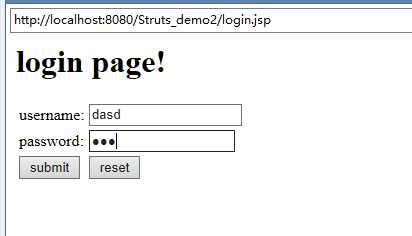
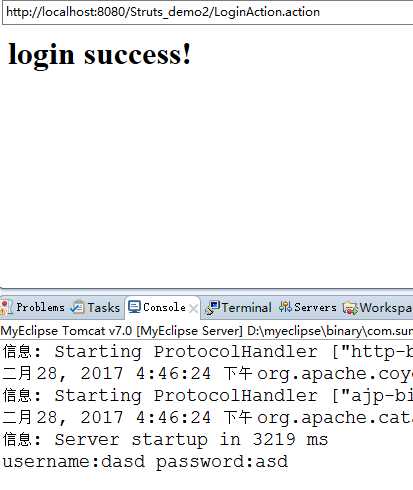
注:特别要注意在使用拦截的器的时候,使用表单传值,会导致Action中获得的属性的值为null,或是其他的默认的初始化值。
1、实现Interceptor接口
-void init()方法:初始化拦截器所需要的资源
-void destory()方法:释放init()中分配的资源
-String intercept(ActionInvocation invocation)throws Exception:实现拦截器功能,利用ActionInvocation参数获取Action状态,返回result字符串作为逻辑视图。
代码:
struts.xml
<?xml version="1.0" encoding="UTF-8" ?> <!DOCTYPE struts PUBLIC "-//Apache Software Foundation//DTD Struts Configuration 2.1//EN" "http://struts.apache.org/dtds/struts-2.1.dtd"> <struts> <package name="default" namespace="/" extends="struts-default"> <!--注册拦截器 --> <interceptors> <interceptor name="timefigureFilter" class="com.third.TimeInterceptor"> </interceptor> </interceptors> <action name="LoginAction" method="login" class="com.third.LoginAction"> <result>/loginSuccess.jsp</result> <interceptor-ref name="timefigureFilter"></interceptor-ref> </action> </package> </struts>
login.jsp
<%@ page language="java" import="java.util.*" pageEncoding="UTF-8"%> <% String path = request.getContextPath(); String basePath = request.getScheme()+"://"+request.getServerName()+":"+request.getServerPort()+path+"/"; %> <!DOCTYPE HTML PUBLIC "-//W3C//DTD HTML 4.01 Transitional//EN"> <html> <head> <base href="<%=basePath%>"> <title>My JSP ‘login.jsp‘ starting page</title> <meta http-equiv="pragma" content="no-cache"> <meta http-equiv="cache-control" content="no-cache"> <meta http-equiv="expires" content="0"> <meta http-equiv="keywords" content="keyword1,keyword2,keyword3"> <meta http-equiv="description" content="This is my page"> <!-- <link rel="stylesheet" type="text/css" href="styles.css"> --> </head> <body> <h1>login page!</h1> <form action="LoginAction.action" method="post"> <table> <tr> <td>username:</td> <td><input type="text" name="username"/></td> </tr> <tr> <td>password:</td> <td><input type="password" name="password"/></td> </tr> <tr> <td><input type="submit" value="submit"></td> <td><input type="reset" value="reset"></td> </tr> </table> </form> </body> </html>
loginSuccess.jsp
<%@ page language="java" import="java.util.*" pageEncoding="UTF-8"%> <% String path = request.getContextPath(); String basePath = request.getScheme()+"://"+request.getServerName()+":"+request.getServerPort()+path+"/"; %> <!DOCTYPE HTML PUBLIC "-//W3C//DTD HTML 4.01 Transitional//EN"> <html> <head> <base href="<%=basePath%>"> <title>My JSP ‘loginSuccess.jsp‘ starting page</title> <meta http-equiv="pragma" content="no-cache"> <meta http-equiv="cache-control" content="no-cache"> <meta http-equiv="expires" content="0"> <meta http-equiv="keywords" content="keyword1,keyword2,keyword3"> <meta http-equiv="description" content="This is my page"> <!-- <link rel="stylesheet" type="text/css" href="styles.css"> --> </head> <body> <h1>login success!</h1> </body> </html>
User.java
package com.third; public class User { private String username; private String password; public String getUsername() { return username; } public void setUsername(String username) { this.username = username; } public String getPassword() { return password; } public void setPassword(String password) { this.password = password; } }
TimeInterceptor.java
1 package com.third; 2 3 import javax.servlet.http.HttpServletRequest; 4 5 import org.apache.struts2.ServletActionContext; 6 7 import com.opensymphony.xwork2.ActionInvocation; 8 import com.opensymphony.xwork2.interceptor.Interceptor; 9 10 public class TimeInterceptor implements Interceptor { 11 12 @Override 13 public void destroy() { 14 // TODO Auto-generated method stub 15 16 } 17 18 @Override 19 public void init() { 20 // TODO Auto-generated method stub 21 22 } 23 24 @Override 25 public String intercept(ActionInvocation invocation) throws Exception { 26 HttpServletRequest request=ServletActionContext.getRequest(); 27 String username=request.getParameter("username"); 28 String password=request.getParameter("password"); 29 request.setAttribute("username", username); 30 //1执行action之前 31 long start=System.currentTimeMillis(); 32 //2执行下一个拦截器,直到最后一个拦截器,则执行目标Action 33 String result=invocation.invoke(); 34 //3执行完action之后 35 long end=System.currentTimeMillis(); 36 System.out.println("执行Action花费的时间为:"+(end-start)+"ms"); 37 return result; 38 } 39 40 }
LoginAction.java
1 package com.third; 2 3 import org.apache.struts2.ServletActionContext; 4 5 import com.opensymphony.xwork2.ActionContext; 6 import com.opensymphony.xwork2.ActionSupport; 7 import com.opensymphony.xwork2.ModelDriven; 8 import com.opensymphony.xwork2.inject.Context; 9 10 public class LoginAction extends ActionSupport implements ModelDriven<User> { 11 12 private User user=new User(); 13 public String login(){
//着重看着两行代码运行打印的结果 14 System.out.println("username:"+user.getUsername());
//System.out.println("username:"+ServletContext.getRequest().getAttribute("username");//这里也可完成正常的获值 15 System.out.println("username:"+ServletActionContext.getRequest().getAttribute("username")); 16 return SUCCESS; 17 } 18 19 @Override 20 public User getModel() { 21 22 return user; 23 } 24 25 }
运行结果截图:
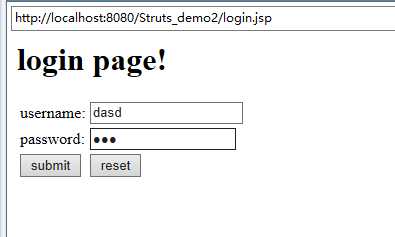
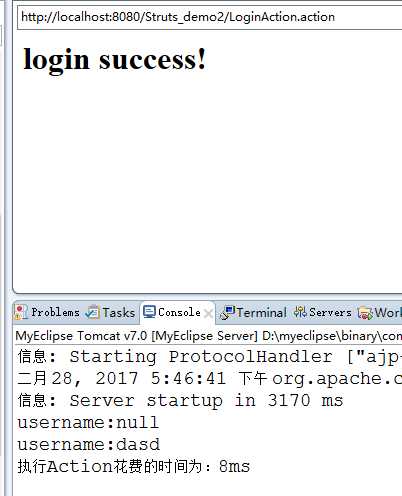
注:注意看结果,打印的第一个username的属性值为null,而第二个为表单填写的dasd。这里涉及到拦截器的使用导致的表单传值问题。
原因:登陆界面填写完成之后,表单需要实现页面跳转,而这些将会交给struts,struts在调用action的过程其实是调用action中的struts.xml配置action标签method属性指定的方法(默认是execute()),而在调用这个方法前会对表单的属性信息将会别匹配赋值给action中同名属性。正常情况下没有自定义的拦截器,通过表单传递的属性值没有问题。
要完成这个功能,有很大程度上, Struts 2 要依赖与 ValueStack 对象。这个对象贯穿整个 Action 的生命周期 (每个 Action 类的对象实例会拥有一个 ValueStack 对象 ) 。当 Struts 2 接收到一个 action 的请求后,会先建立Action 类的对象实例,但不会调用 Action 方法,而是先将 Action 类的相应属性放到 ValueStack 对象的顶层节点(ValueStack 对象相当于一个栈 ). 只是所有的属性值都是默认的值,如 String 类型的属性值为 null,int 类型的属性值为 0 等。
在处理完上述工作后, Struts 2 就会调用拦截器链中的拦截器,当调用完所有的拦截器后,最后会调用 Action 类的 Action 方法,在调用 Action 方法之前,会将 ValueStack 对象顶层节点中的属性值赋给 Action 类中相应的属性。大家要注意,在这里就给我们带来了很大的灵活性。也就是说,在 Struts 2 调用拦截器的过程中,可以改变ValueStack 对象中属性的值,当改变某个属性值后, Action 类的相应属性值就会变成在拦截器中最后改变该属性的这个值。
好多废话~总结就是:在拥有自定义的过滤器时,表单传属性值会先赋值给Action中属性,当运行完过滤器时,才会调用Action中的方法,在调用之前会将 ValueStack 对象中的默认初始化值赋给action中的属性,然后调用action中的方法,这样action中的属性全是ValueStack 对象中的默认初始化值。
解决的方法:间接访问Servlet的API,通过request对象去访问属性和属性值。如:
HttpServletRequest request=ServletActionContext.getRequest();
String username=request.getParameter("username");
-提供了init()和destroy()方法的实现
-只需要实现intercept()方法即可
代码:
struts.xml
<?xml version="1.0" encoding="UTF-8" ?> <!DOCTYPE struts PUBLIC "-//Apache Software Foundation//DTD Struts Configuration 2.1//EN" "http://struts.apache.org/dtds/struts-2.1.dtd"> <struts> <package name="default" namespace="/" extends="struts-default"> <!--注册拦截器 --> <interceptors> <interceptor name="timefigureFilter1" class="com.third1.TimeInterceptor"> </interceptor> </interceptors> <action name="TimeAction" class="com.third1.TimeAction"> <result>/index.jsp</result> <!--引用拦截器 --> <interceptor-ref name="timefigureFilter1"></interceptor-ref> </action> </package> </struts>
TimeInterceptor.java
1 package com.third1; 2 3 import org.apache.struts2.ServletActionContext; 4 5 import com.opensymphony.xwork2.ActionInvocation; 6 import com.opensymphony.xwork2.interceptor.AbstractInterceptor; 7 8 public class TimeInterceptor extends AbstractInterceptor { 9 10 @Override 11 public String intercept(ActionInvocation invocation) throws Exception { 12 //1.执行action之前 13 long start=System.currentTimeMillis(); 14 //2.执行下一个拦截器,如果已经是最后一个拦截器,则执行目标Action 15 16 ServletActionContext.getRequest().setAttribute("username", "小帅哥"); 17 ServletActionContext.getRequest().getSession().setAttribute("username","小美女"); 18 ServletActionContext.getServletContext().setAttribute("username", "少艾"); 19 String result=invocation.invoke(); 20 //3.执行Action之后 21 long end=System.currentTimeMillis(); 22 System.out.println("执行Action花费的时间:"+(end-start)+"ms"); 23 //获取request对象,调用其setAttribute函数,将时间作为属性保存到request对象中 24 ServletActionContext.getRequest().setAttribute("time", (end-start)); 25 ServletActionContext.getRequest().getSession().setAttribute("time1",(end-start)); 26 ServletActionContext.getServletContext().setAttribute("time2", (end-start)); 27 return result; 28 } 29 30 }
TimeAction.java
1 package com.third1; 2 3 import com.opensymphony.xwork2.ActionSupport; 4 5 public class TimeAction extends ActionSupport { 6 7 @Override 8 public String execute() throws Exception{ 9 10 for(int i=0;i<3;i++){ 11 Thread.sleep(1000); 12 } 13 return SUCCESS; 14 } 15 }
index.jsp
<%@ page language="java" import="java.util.*" pageEncoding="UTF-8"%> <% String path = request.getContextPath(); String basePath = request.getScheme()+"://"+request.getServerName()+":"+request.getServerPort()+path+"/"; %> <!DOCTYPE HTML PUBLIC "-//W3C//DTD HTML 4.01 Transitional//EN"> <html> <head> <base href="<%=basePath%>"> <title>My JSP ‘index.jsp‘ starting page</title> <meta http-equiv="pragma" content="no-cache"> <meta http-equiv="cache-control" content="no-cache"> <meta http-equiv="expires" content="0"> <meta http-equiv="keywords" content="keyword1,keyword2,keyword3"> <meta http-equiv="description" content="This is my page"> <!-- <link rel="stylesheet" type="text/css" href="styles.css"> --> </head> <body> <h1>执行Action用户名:<%=request.getAttribute("username") %>(通过request方式获取)</h1> <h1>执行Action用户名:<%=session.getAttribute("username") %>(通过session方式获取)</h1> <h1>执行Action用户名:<%=application.getAttribute("username") %>(通过application方式获取)</h1> <h1>执行Action花费的时间:<%=request.getAttribute("time") %>(通过request方式获取)</h1> <h1>执行Action花费的时间:<%=session.getAttribute("time1") %>(通过session方式获取)</h1> <h1>执行Action花费的时间:<%=application.getAttribute("time2") %>(通过application方式获取)</h1> </body> </html>
运行结果截图:

分析:对比两种颜色标记的代码区,对比一下他们,并且结合结果进行分析。我们不难发现过滤器的调用分为两个阶段,第一个阶段是在产生HttpServletRequest请求之后、action方法调用之前;第二阶段是产生与action之后,jsp页面(Template显示)跳转之后,HttpServletResponse之前。所以当你在 String result=invocation.invoke(); 这条语句之后通过request,application,session给它设置属性值,将会没有起到任何作用。
可以结合struts2的工作原理及文件结构图进行参考。
标签:ref 实现 color 节点 config 标签 table path ping
原文地址:http://www.cnblogs.com/xiaotiaosi/p/6480730.html